A landing page is a web page designed to attract the consumers who are in the market for the product or service your business offers. Also known as a lead capture page, landing pages are the web page a user "lands on" after clicking on an advertisement or social media post.
Whether you aim to generate more leads for your business through paid advertising or brand awareness on social media, you will want to offer a free resource such as a lead magnet in exchange for the visitor’s contact information.
Lead capture pages are designed to collect prospects' contact information like name, email address, company name, among other details. With this data, you can determine whether a prospect is a qualified lead, store them in your email list, and nurture them into a paying customer.
In this post, we will discuss the elements that every lead generation landing page requires to successfully generate high quality leads.
The Lead Generation landing page
The best landing pages are those that clearly define their target audience and generate quality leads. To achieve this, you will need to be clear of which of your buyer personas you aim to attract with each lead capture page.
Target your buyer personas
From HubSpot, a buyer persona is a semi-fictional representation of your ideal customer based on market research and existing information about your ideal customer.
Using available data on their demographics, pain points, the best ways to interact with them, and preferred method of contact, will give you insight into increasing your landing pages’ overall reach.
Answering questions like Where can I find these buyer personas? and What would incentivize them to provide their contact information to my business? will give you an understanding of where to place links to your landing pages and the type of content upgrades to offer.
Define your conversion goals
Successful landing pages focus on a specific stream of traffic – this could be to generate brand awareness from a search ad campaign or promote a free tool your business offers. Therefore, an effective landing page should have one conversion goal.
Examples of common landing page conversion goals include:
- Completion of the lead capture form
- A product or service inquiry
- A newsletter signup
- A lead magnet download
Sticking to one conversion goal per landing page will allow you to focus on a specific offer and evaluate how useful it is. On the contrary, if you concentrate on more than one conversion goal, it will be more difficult to structure your page to meet both objectives.
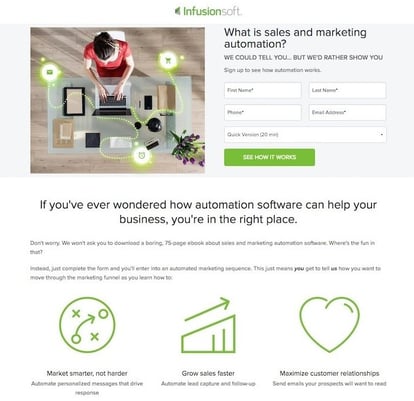 (Source: Instapage)
(Source: Instapage)
When to run a lead generation landing page campaign
If you are just getting started, creating an effective landing page may take some time.
While you may need to craft a landing page for a variety of reasons, make sure you build them when your business faces any of the following circumstances.
Multiple Products
When you are running a campaign for a physical or digital product, landing pages are an excellent tool. With it, you can collect contact information from consumers who have an interest in learning more about the item and its different use cases.
Segmented Promotional Offers
If your business sells a product or service that will attract different types of customers, create various landing pages to cater to each.
Multiple Traffic Sources
Creating a landing page that matches each traffic source is vital for higher lead conversions if you are running a marketing campaign across various platforms.
Lead Generation landing pages increase your conversion rates
Landing pages that focus on a single campaign and tailor to specific platforms have a higher chance of capturing quality leads.
For example, a landing page that web users are taken to after clicking on a sponsored search ad will convert more leads when it replicates the offer mentioned in the search ad.
Lead capture pages that show what the user is looking for – they are specific, customized to the target audience's interest, and provide a good user experience – are the best at generating leads.
Landing page vs Home page
While a landing page and a website’s homepage may look the same to the untrained eye, they are two different things.
A homepage will have a navigation bar and outbound links that visitors can use for easy access to the website’s content. It is designed to help your visitors explore your site, marketing content, and learn about your brand and corporate values. With so many elements on a single page, it is unlikely a homepage will help convert new leads.
On the other hand, landing pages provide visitors with a single content offer to convert them into leads. This is in your best interest – promoting multiple offers on a single landing page can decrease conversions by a whopping 266%.
To increase your lead capture pages’ conversions, there two factors that go into making this happen: the attention ratio and message match.
The attention ratio
The attention ratio refers to the number of elements on your web page that can capture a user’s attention versus the number that should.
For example, Advanced Hair Studio’s landing page has various images that distract viewers from the $350 off promotion. In this case, the attention ration would likely be 10:1 – 10 diverse factors are vying for the attention of one individual.
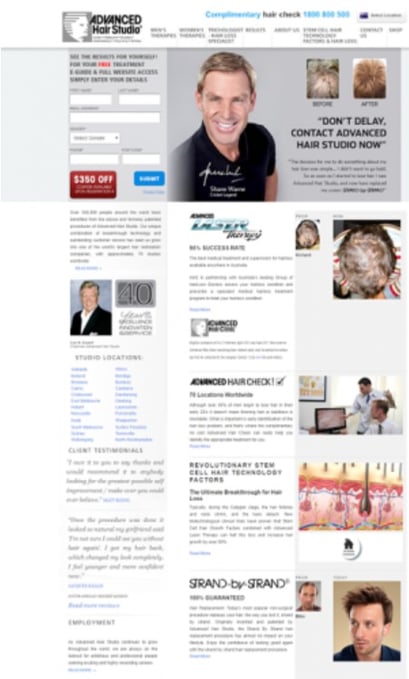 (Source: Autogrow)
(Source: Autogrow)
Ideally, you want your landing pages’ attention ratio to be as close as possible to 1:1. While this may not always be possible, you can increase visitors' attention by omitting any links that can lead a user away from your web page.
The message match
Message match is the action of reflecting your ad copy or the copy from the social media post that got the user to your landing page.
For example, Moz does a great job of matching their social media copy promoting an upcoming webinar to the copy in the corresponding lead generation landing page.
Message match helps users reinforce the idea that clicking on your ad or social media post was a good one.
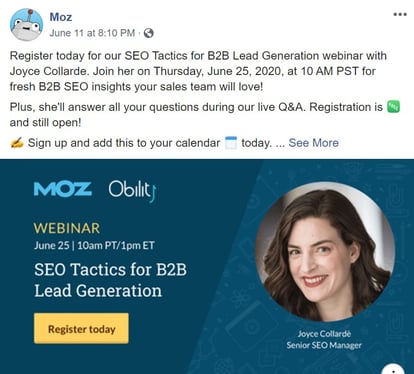
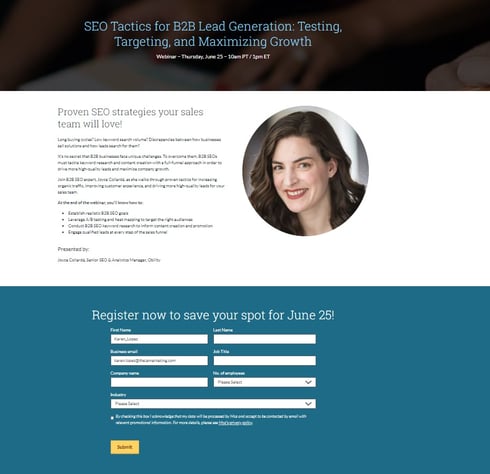 (Source: Moz)
(Source: Moz)
Landing page optimization tips
Successful lead generation landing pages do not need to be fancy, but they will require you to put in some work.
Given that one of your landing pages may be the first point of contact someone has with your brand, you will want all your lead capture pages to reflect your business’s professionalism and mission to provide value.
Prime lead generation landing pages will follow a structure like this one from Unbounce.
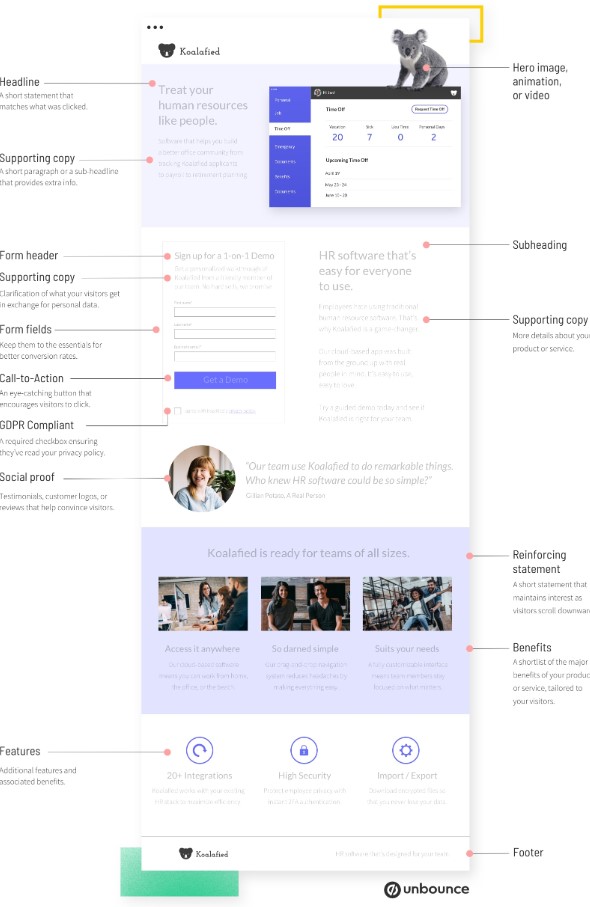 (Source: Unbounce)
(Source: Unbounce)
Landing page elements
A landing page will successfully capture quality leads if consumers who are genuinely interested in the offer it provides can see the web page. Other factors that influence its conversion rates include:
Unique Selling Proposition (USP)
Your unique selling proposition will answer what makes your product or service unique. You want to communicate to your visitors why they should care about you.
The average attention span is 8 seconds; therefore, you will want to describe a USP that helps consumers determine if they want to take up the offer or leave the page.
The main headline of your landing page is the first thing users will see once the web page loads. Therefore, be explicit about what makes your product or service remarkable.
The supporting headline works to complement your main headline and provide a bit more information on the topic.
A central image or video
Information is central to a landing page, but so are visuals. By implementing a central image or video, you ensure that your web page can grasp the user’s attention. Embedding a video on your landing pages can increase your conversion rate by 86%.
Make sure the visuals you choose add to the overall message.
The benefit(s) of your lead magnet
While lead magnets are technically "free," a visitor to your landing page is required to provide their contact information to gain access to your offer.
While your headline and supporting headline work together to emphasize your product or service's overall advantage, users are interested in the added benefit(s) of your content offer.
To help drive more conversions, mention the benefits and features of your product. Be wary of confusing these two:
- A feature is a quality or characteristic of your product or service.
- A benefit is the positive effect of that feature.
For example, a benefit and a feature in practice: Improve your business’s online reputation with Theia Marketing’s top-tier Reputation Management services.
The image below is a landing page from Unbounce and does a magnificent job of showcasing the features and benefits of their software.
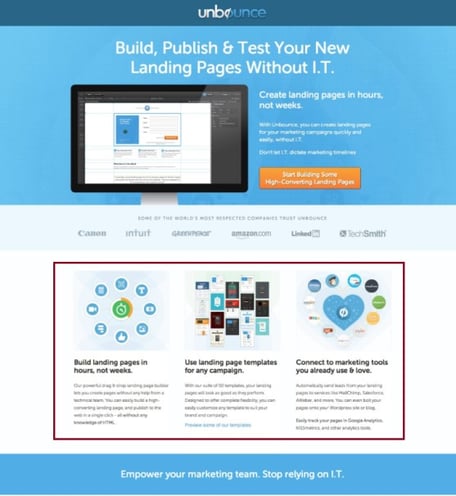 (Source: Moz)
(Source: Moz)
Social proof
Wikipedia defines social proof as the psychological phenomenon where people assume others' actions to reflect correct behavior for a given situation.
Social proof is key to making your landing pages successful because it lets other visitors to your web page know that your content offer does it what claims to do, and your business is reliable.
On lead capture pages, social proof can look like any of these options:
- Case studies or links to case studies
- Direct testimonials from clients
- Video interviews
- Logos of client companies
- Reviews on websites like Google My Business, Yelp, Capterra, and G2Crowd
- Comments from customers on social media platforms
Rest assured that consumers will consult any of the above sources before submitting their contact information to ensure that your business is reliable and worth their time investment.
A call-to-action (CTA)
Your landing page’s call-to-action will reflect the conversion goal you have set for that page. Remember that each landing page should focus on one conversion goal.
If you have goals you want to achieve, create multiple landing pages. Call-to-actions like “Click here” and “Go” generate 30% and 25% of all conversions. Other high-converting CTA's include “Get Started”, “Sign up free”, "Download Now”, and “Enter here.”
Each element contributes to a landing page’s overall aesthetic and works together to persuade the visitor to provide their contact information. Nine times out of ten, this will be in exchange for a content offer.
Lead generation landing pages serve a specific purpose
Lead generation landing pages can make or break a paid ad campaign or a social media brand awareness campaign.
Crafting a different landing page for every campaign may seem like a daunting task. By defining your individual conversion goals, aligning your message to line up with your content offers, and incorporating elements of a high-converting landing page, your lead capture pages will generate more quality leads.




